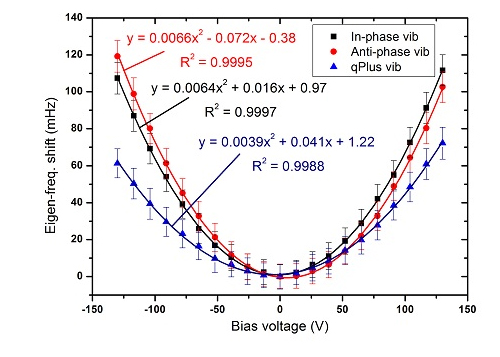The piezoelectric effects exist in dielectric materials with non-centrosymmetric lattice structure and it is the coupling of the mechanical and electric properties. Quartz tuning fork (QTF) is such a piezoelectric device that has been widely used such as the time sources in wrist watch and the micro-cantilever in atomic force microscopes with atomic resolution. Prof. Lu’s lab in HMFL recently found that in QTF there exists a sensitive dependence of its resonant frequency shift on the bias votage applied on its prongs.
Systematic studies suggest that, in all the three oscillation modes, this dependence shows a parabolic relation (see the figure below) and the dependence is very sensitive. For example, when the QTF oscillates as a qPlus, the frequency shift is only 470 nHz if the bias voltage varies only 1 mV at the bias voltage of 130 V. Thus, it may find applications in frequency modulation and measurements with ultra-high sensitivity.
The authors explained this effect using a phenomenological model. Due to the piezoelectric effect, the applied voltage will cause an intrinsic strain in the prongs of the QTF, thus the spring constant will change a little. This model can qualitatively explain this parabolic relation.
This work has been published in Sensors, 14, 21941-21949 (2014).
The link to the paper: http://www.mdpi.com/1424-8220/14/11/21941
